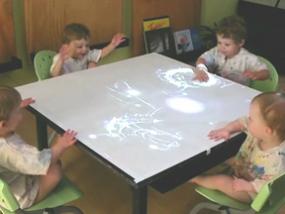Table Lights as a Medium to Move

Four children, each a little over a year old, sit around a square table, covered with white paper onto which a video projector casts lights from a computer. The lights change pattern in sync with music. The children do not control the movement of the lights, but at times they think that they do. This set-up, flowing light patterns on a tabletop, generates an uncommon form of play with lights. The children splash and smear the light as if it were a moveable medium, such as water or finger paint. We need to understand why this happens. First, watch the clip, and then let’s identify some revealing moments.
At various points, the children reveal that they are trying to touch, halt, move, splash, or smear the lights. The feeling of self-as-cause comes through most clearly when the child in the upper left exclaims at 00:27 “I did it.” A few seconds before (00:21) a solid spot of light scattered into a ring when he touched it.
We can speculate that the temptation to attribute cause-to-self comes from several sources. First, this type of self-as-center defines a way of thinking typical of children this age. Second, the swirls and spots of light change in a pattern sufficiently random that some slaps seem to cause the light spots to change. Third, the lights appear to come from the table’s surface. Such tabletop visual arrays usually occur on the water’s surface in a water table or from finger paint spread over the table’s surface; set-ups where touch does affect the visual array. The children are most likely treating the light on the table as a moveable medium. They assimilate the new events (light flowing on table) to more familiar events (water rippling in a basin). Fourth, the children might sense that the light is determined by changes in the music. They do stop their slapping when the music and lights stop abruptly (02:10). Therefore, the lights live in a context of determinism, even though the children have no more control over the musical patterns than they do over the light patterns. Fifth, the children are arranged facing inward towards one another, around the table. This arrangement causes one child to be influenced by another and supports group glee, a type of animated joy when children realize they all share a common excitement.
We need to distinguish actions intended to move or splash the light spots from actions that are more social, as when one child imitates another. You can distinguish the difference by looking at the children’s eyes. When the child looks carefully at the spot as it is grabbed or slapped, we speculate that he expects the light to respond. When the child slaps the table in unison with the other children, while looking at his friends, we speculate that the intention is more about social participation than about moving the lights. This set-up generates both forms of play. We believe this is good. The children’s orientation to one another also leads to discoveries about cause.
One wonders if the children are learning that their actions do not affect the lights. They cannot cover and hide the lights. They cannot prevent them from moving. They cannot cause the lights to appear, to scatter, or to disappear. But to learn the randomness of these effects the children would have to make at least a crude calculation that mixed in with those accidental contingencies that look like, “I did it” are many non-contingencies. It would be too much to expect one-year-old children to pause, test, and reject the idea that hand actions cause the changes in the lights. Yet, we do see inklings of just these sorts of pauses when the lights appear on top of the hand or when the child points at, rather than grabs, a well defined spot of light.
This tabletop experience can be treated as an opportunity for children to invent strategies that help them distinguish the random from the determined, or in this case, to distinguish events that are randomly determined by a source external to the self. And of course, it is a great deal of fun.
Once they discover that they actually have no control over the lights, the children could still find great joy in pretending that they do. They are not there yet, but you will later observe this awareness of the pretense in the form of exaggerated conducting, like pretending to lead the orchestra, and a lot more smiling at the other children. Pretense always has some element of meta-knowledge, i.e. knowing what you know, knowing that what you are doing is not really doing. Pretense also gives the child a sense of empowerment, and thereby supports the development of new ideas that could have ultimate utility. Run time: 2 minutes 40 seconds
